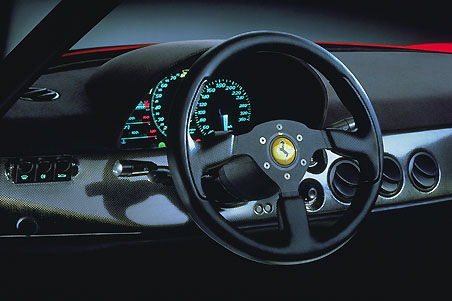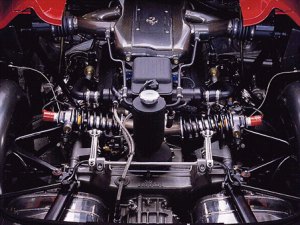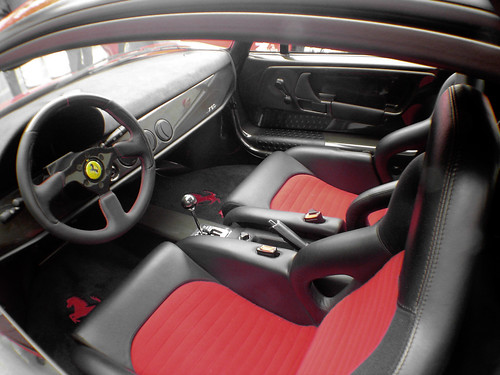Ferrari F50 was designed solely for its purpose: there was no styling in the normal sense of the word. The surfaces enveloped the mechanicals in a single sweep from the front air intake to the rear spoiler. Volumes were kept to the minimum required by the project.
Ferrari F50
Aerodynamics played an important role from the beginning of the Ferrari F50 project because: it was a highly advanced car in terms of performance; there was a link between the internal aerodynamic components (cross flows) and surface layer flows, there needed to be a balance between aerodynamic loads in the dual configuration because of the high performance.

Ferrari F50 is low slung boasting enormous front air intakes. Its sleek lines sweep majestically back to the rear airfoil and the area behind the seats is characterised by aerodynamically designed slopes.
The 4.7 litre engine produces 520 bhp, propelling the Ferrari F50 from 0-60 mph in just 3.7 seconds. The carbon fibre body is capable of reaching an incredible top speed of 203 mph.
Ferrari F50 Ferrari F50
Ferrari F50 has a twelve cylinder, 4,75 liter, rear mounted engine slams out 520 horsepower, flashing the car from 0-60 miles per hour in 34,7 sec and taking the carbon fiber body to a top speed of 203 mph. The engine
of the Ferrari F50 is visible through part of the transparent vented engine cover.

The chassis of the Ferrari F50 is made entirely of carbon fibre weighing 225 lbs and offering a torsional rigidity of 25.677 lb-ft.
Ferrari F50 Ferrari F50
Like a Formula 1 car occupants sit in the central tub formed by the chassis and the aeronautical rubber fuel cell is located in a protected position between the passenger tub and the engine and rear suspension.
The engine of the Ferrari F50 is like a support for the suspension, rear bumper and bodywork elements.The cylinder head of the Ferrari F50 has five radial valves per cylinder. This is an ideal solution for engines capable of high speeds that close valves pneumatically. The five valves (3 intake and 2 exhaust) are smaller and therefore the flutter speed is raise above 10,000 rpm. A 5 valve arrangement makes it possible to achieve a high degree of permeability of the intake ducts.
Ferrari F50 Ferrari F50 Ferrari F50
Ferrari F50 is fitted with an insulated stainless steel exhaust system. A throttle valve driven by the Motronic control unit made 2 exhaust system lengths available.






0 Comment:
Post a Comment